NURS4001: Pressure Injury Clinical Audit at Singapore General Hospital
VerifiedAdded on 2022/10/04
|14
|3450
|48
Report
AI Summary
This report details a clinical audit conducted at Singapore General Hospital (SGH) focusing on pressure injuries, a significant patient safety concern. The audit evaluates nurses' competency, adherence to prevention protocols, and participation in quality improvement initiatives. The study employs a prospective design and utilizes the PDSA cycle to develop and implement changes aimed at enhancing patient care. The report provides background information on pressure injuries, baseline measurements of nurse performance, a process map outlining the audit's stages, and a strategy for implementing improvements. The audit assesses nurses' knowledge, adherence to standards, and involvement in quality improvement activities. The results of the audit are presented, along with a discussion of strengths, limitations, and ethical considerations. The report concludes with recommendations for improving pressure injury management and ensuring patient safety at SGH. The report also highlights the importance of training nurses and implementing the NSQHS Standards to improve patient outcomes and reduce healthcare costs.
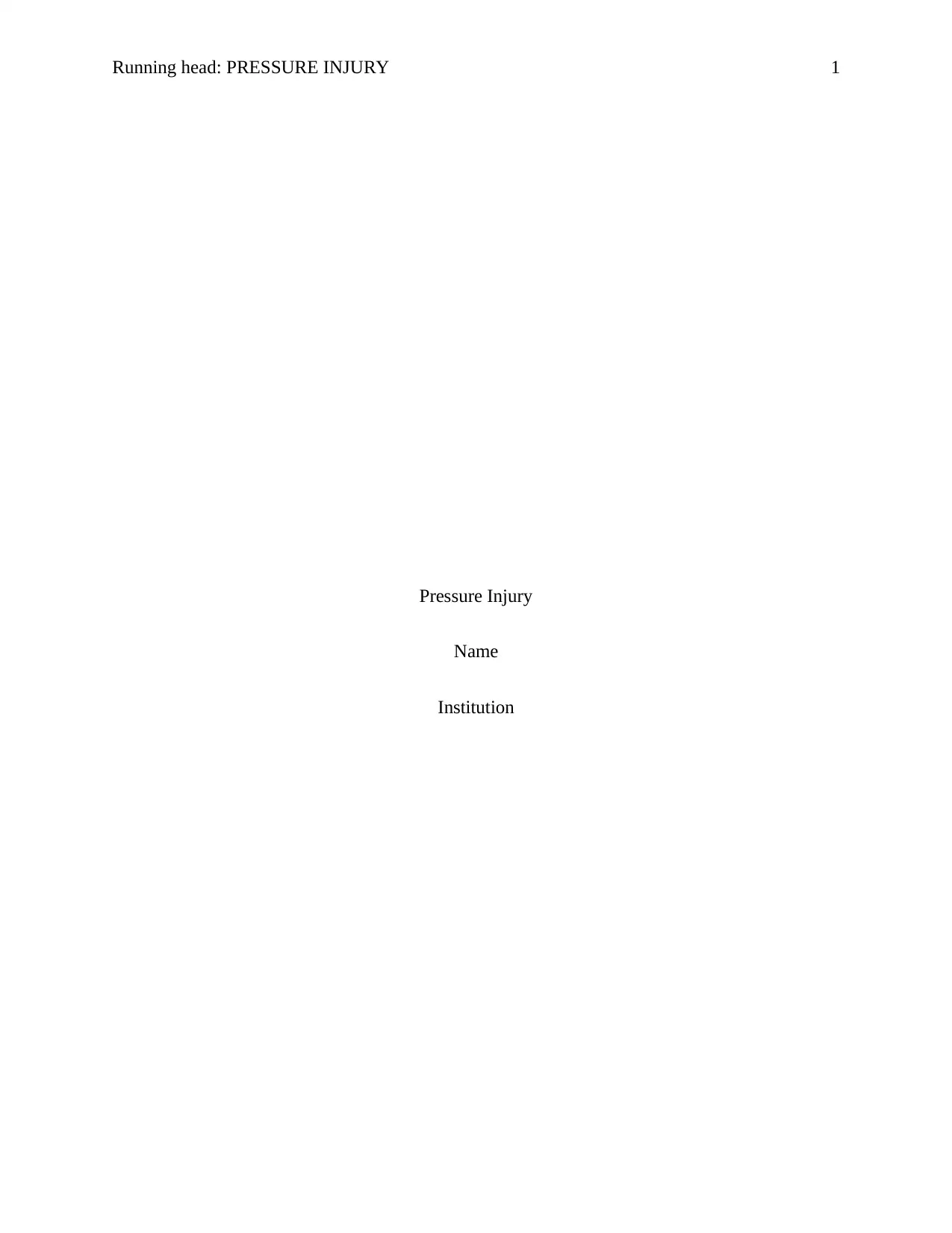
Running head: PRESSURE INJURY 1
Pressure Injury
Name
Institution
Pressure Injury
Name
Institution
Paraphrase This Document
Need a fresh take? Get an instant paraphrase of this document with our AI Paraphraser
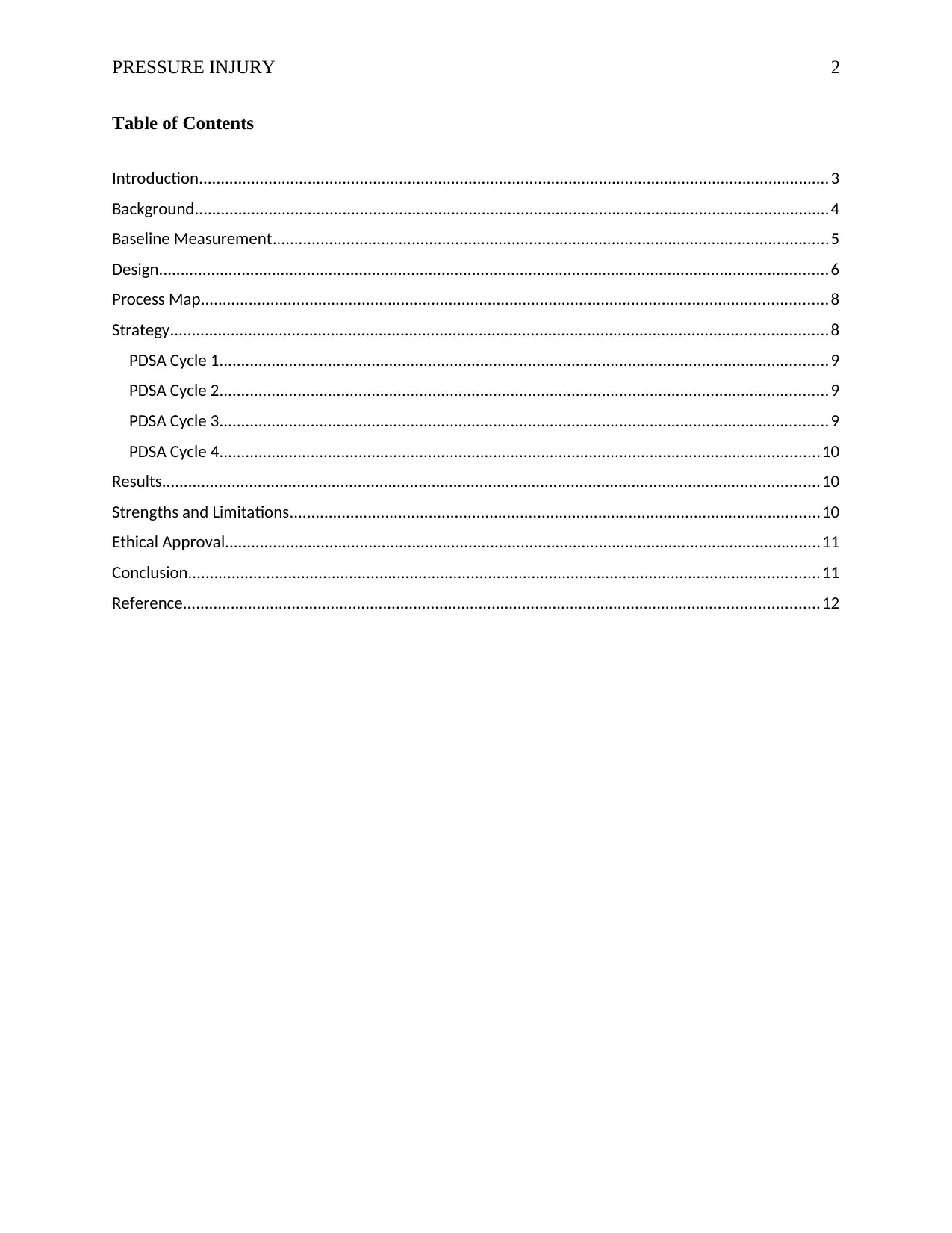
PRESSURE INJURY 2
Table of Contents
Introduction.................................................................................................................................................3
Background..................................................................................................................................................4
Baseline Measurement................................................................................................................................5
Design..........................................................................................................................................................6
Process Map................................................................................................................................................8
Strategy.......................................................................................................................................................8
PDSA Cycle 1............................................................................................................................................9
PDSA Cycle 2............................................................................................................................................9
PDSA Cycle 3............................................................................................................................................9
PDSA Cycle 4..........................................................................................................................................10
Results.......................................................................................................................................................10
Strengths and Limitations..........................................................................................................................10
Ethical Approval.........................................................................................................................................11
Conclusion.................................................................................................................................................11
Reference..................................................................................................................................................12
Table of Contents
Introduction.................................................................................................................................................3
Background..................................................................................................................................................4
Baseline Measurement................................................................................................................................5
Design..........................................................................................................................................................6
Process Map................................................................................................................................................8
Strategy.......................................................................................................................................................8
PDSA Cycle 1............................................................................................................................................9
PDSA Cycle 2............................................................................................................................................9
PDSA Cycle 3............................................................................................................................................9
PDSA Cycle 4..........................................................................................................................................10
Results.......................................................................................................................................................10
Strengths and Limitations..........................................................................................................................10
Ethical Approval.........................................................................................................................................11
Conclusion.................................................................................................................................................11
Reference..................................................................................................................................................12
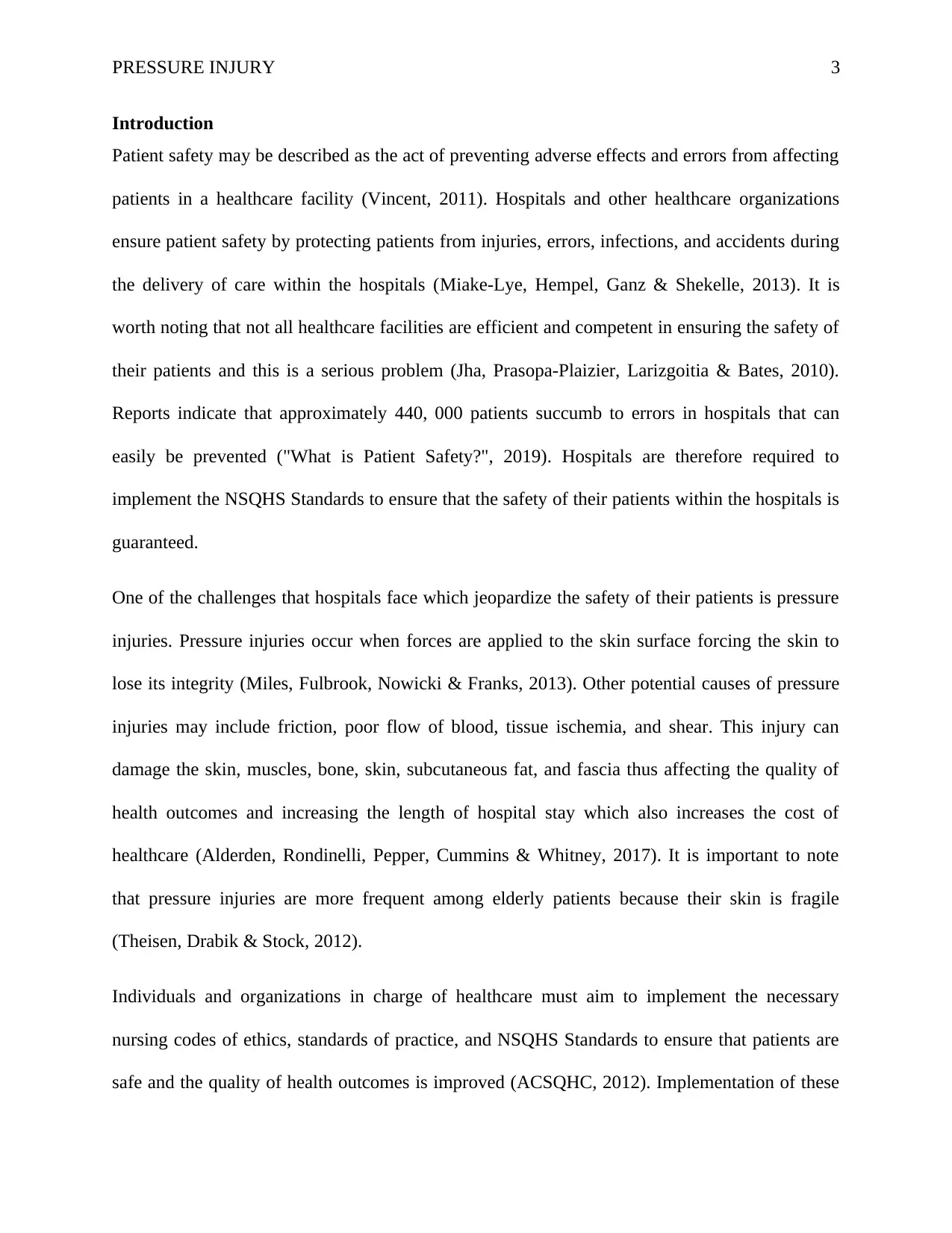
PRESSURE INJURY 3
Introduction
Patient safety may be described as the act of preventing adverse effects and errors from affecting
patients in a healthcare facility (Vincent, 2011). Hospitals and other healthcare organizations
ensure patient safety by protecting patients from injuries, errors, infections, and accidents during
the delivery of care within the hospitals (Miake-Lye, Hempel, Ganz & Shekelle, 2013). It is
worth noting that not all healthcare facilities are efficient and competent in ensuring the safety of
their patients and this is a serious problem (Jha, Prasopa-Plaizier, Larizgoitia & Bates, 2010).
Reports indicate that approximately 440, 000 patients succumb to errors in hospitals that can
easily be prevented ("What is Patient Safety?", 2019). Hospitals are therefore required to
implement the NSQHS Standards to ensure that the safety of their patients within the hospitals is
guaranteed.
One of the challenges that hospitals face which jeopardize the safety of their patients is pressure
injuries. Pressure injuries occur when forces are applied to the skin surface forcing the skin to
lose its integrity (Miles, Fulbrook, Nowicki & Franks, 2013). Other potential causes of pressure
injuries may include friction, poor flow of blood, tissue ischemia, and shear. This injury can
damage the skin, muscles, bone, skin, subcutaneous fat, and fascia thus affecting the quality of
health outcomes and increasing the length of hospital stay which also increases the cost of
healthcare (Alderden, Rondinelli, Pepper, Cummins & Whitney, 2017). It is important to note
that pressure injuries are more frequent among elderly patients because their skin is fragile
(Theisen, Drabik & Stock, 2012).
Individuals and organizations in charge of healthcare must aim to implement the necessary
nursing codes of ethics, standards of practice, and NSQHS Standards to ensure that patients are
safe and the quality of health outcomes is improved (ACSQHC, 2012). Implementation of these
Introduction
Patient safety may be described as the act of preventing adverse effects and errors from affecting
patients in a healthcare facility (Vincent, 2011). Hospitals and other healthcare organizations
ensure patient safety by protecting patients from injuries, errors, infections, and accidents during
the delivery of care within the hospitals (Miake-Lye, Hempel, Ganz & Shekelle, 2013). It is
worth noting that not all healthcare facilities are efficient and competent in ensuring the safety of
their patients and this is a serious problem (Jha, Prasopa-Plaizier, Larizgoitia & Bates, 2010).
Reports indicate that approximately 440, 000 patients succumb to errors in hospitals that can
easily be prevented ("What is Patient Safety?", 2019). Hospitals are therefore required to
implement the NSQHS Standards to ensure that the safety of their patients within the hospitals is
guaranteed.
One of the challenges that hospitals face which jeopardize the safety of their patients is pressure
injuries. Pressure injuries occur when forces are applied to the skin surface forcing the skin to
lose its integrity (Miles, Fulbrook, Nowicki & Franks, 2013). Other potential causes of pressure
injuries may include friction, poor flow of blood, tissue ischemia, and shear. This injury can
damage the skin, muscles, bone, skin, subcutaneous fat, and fascia thus affecting the quality of
health outcomes and increasing the length of hospital stay which also increases the cost of
healthcare (Alderden, Rondinelli, Pepper, Cummins & Whitney, 2017). It is important to note
that pressure injuries are more frequent among elderly patients because their skin is fragile
(Theisen, Drabik & Stock, 2012).
Individuals and organizations in charge of healthcare must aim to implement the necessary
nursing codes of ethics, standards of practice, and NSQHS Standards to ensure that patients are
safe and the quality of health outcomes is improved (ACSQHC, 2012). Implementation of these
⊘ This is a preview!⊘
Do you want full access?
Subscribe today to unlock all pages.

Trusted by 1+ million students worldwide
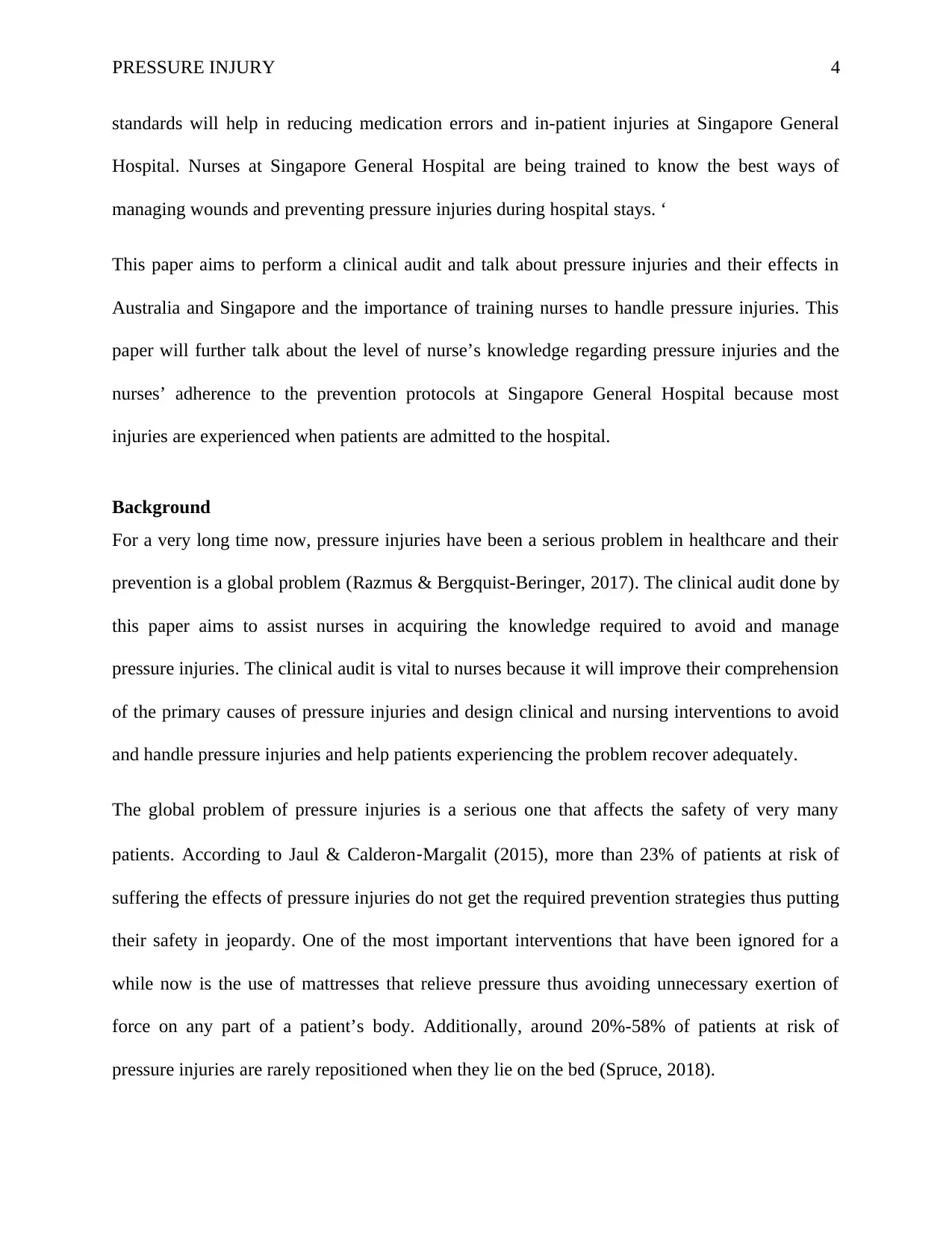
PRESSURE INJURY 4
standards will help in reducing medication errors and in-patient injuries at Singapore General
Hospital. Nurses at Singapore General Hospital are being trained to know the best ways of
managing wounds and preventing pressure injuries during hospital stays. ‘
This paper aims to perform a clinical audit and talk about pressure injuries and their effects in
Australia and Singapore and the importance of training nurses to handle pressure injuries. This
paper will further talk about the level of nurse’s knowledge regarding pressure injuries and the
nurses’ adherence to the prevention protocols at Singapore General Hospital because most
injuries are experienced when patients are admitted to the hospital.
Background
For a very long time now, pressure injuries have been a serious problem in healthcare and their
prevention is a global problem (Razmus & Bergquist-Beringer, 2017). The clinical audit done by
this paper aims to assist nurses in acquiring the knowledge required to avoid and manage
pressure injuries. The clinical audit is vital to nurses because it will improve their comprehension
of the primary causes of pressure injuries and design clinical and nursing interventions to avoid
and handle pressure injuries and help patients experiencing the problem recover adequately.
The global problem of pressure injuries is a serious one that affects the safety of very many
patients. According to Jaul & Calderon‐Margalit (2015), more than 23% of patients at risk of
suffering the effects of pressure injuries do not get the required prevention strategies thus putting
their safety in jeopardy. One of the most important interventions that have been ignored for a
while now is the use of mattresses that relieve pressure thus avoiding unnecessary exertion of
force on any part of a patient’s body. Additionally, around 20%-58% of patients at risk of
pressure injuries are rarely repositioned when they lie on the bed (Spruce, 2018).
standards will help in reducing medication errors and in-patient injuries at Singapore General
Hospital. Nurses at Singapore General Hospital are being trained to know the best ways of
managing wounds and preventing pressure injuries during hospital stays. ‘
This paper aims to perform a clinical audit and talk about pressure injuries and their effects in
Australia and Singapore and the importance of training nurses to handle pressure injuries. This
paper will further talk about the level of nurse’s knowledge regarding pressure injuries and the
nurses’ adherence to the prevention protocols at Singapore General Hospital because most
injuries are experienced when patients are admitted to the hospital.
Background
For a very long time now, pressure injuries have been a serious problem in healthcare and their
prevention is a global problem (Razmus & Bergquist-Beringer, 2017). The clinical audit done by
this paper aims to assist nurses in acquiring the knowledge required to avoid and manage
pressure injuries. The clinical audit is vital to nurses because it will improve their comprehension
of the primary causes of pressure injuries and design clinical and nursing interventions to avoid
and handle pressure injuries and help patients experiencing the problem recover adequately.
The global problem of pressure injuries is a serious one that affects the safety of very many
patients. According to Jaul & Calderon‐Margalit (2015), more than 23% of patients at risk of
suffering the effects of pressure injuries do not get the required prevention strategies thus putting
their safety in jeopardy. One of the most important interventions that have been ignored for a
while now is the use of mattresses that relieve pressure thus avoiding unnecessary exertion of
force on any part of a patient’s body. Additionally, around 20%-58% of patients at risk of
pressure injuries are rarely repositioned when they lie on the bed (Spruce, 2018).
Paraphrase This Document
Need a fresh take? Get an instant paraphrase of this document with our AI Paraphraser
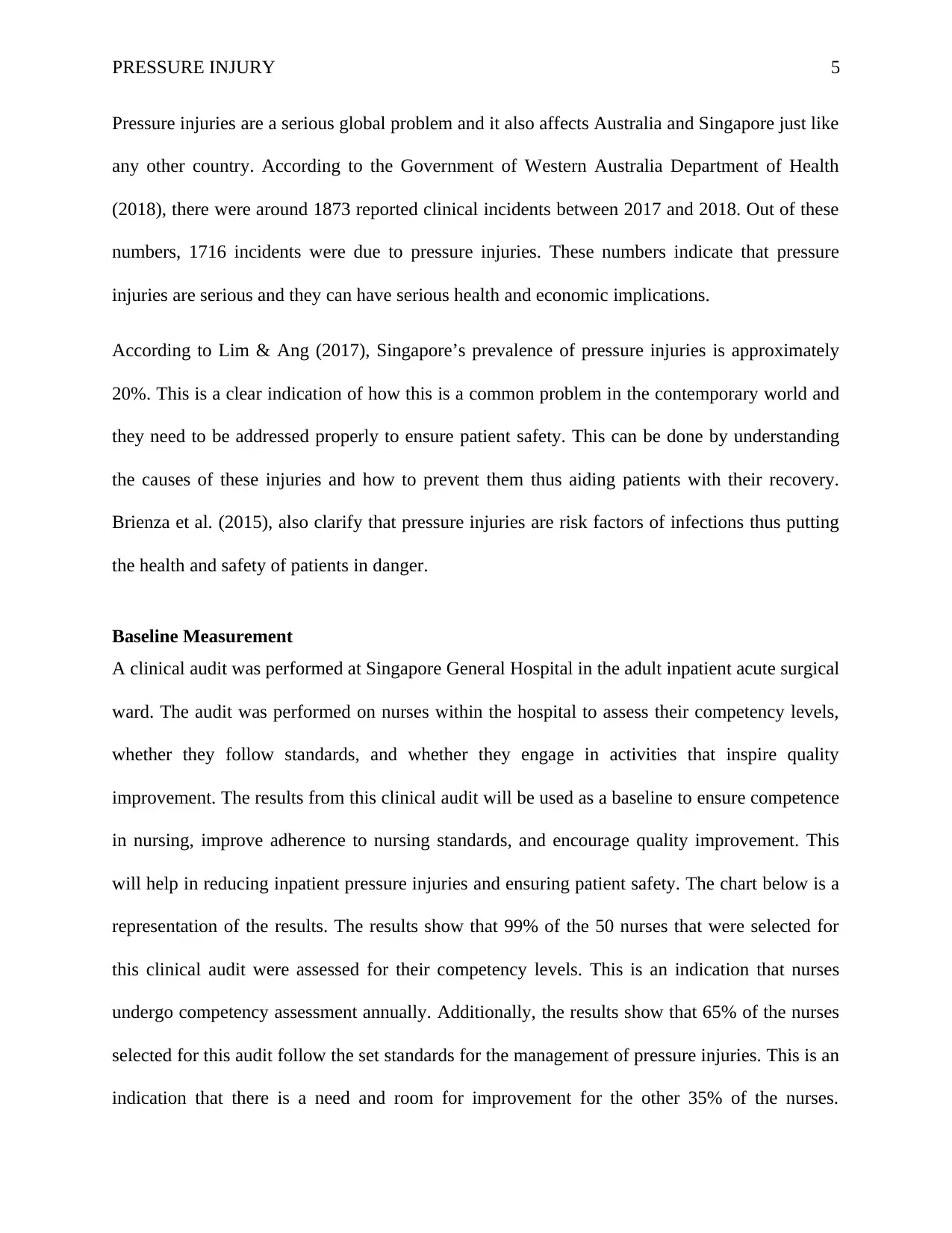
PRESSURE INJURY 5
Pressure injuries are a serious global problem and it also affects Australia and Singapore just like
any other country. According to the Government of Western Australia Department of Health
(2018), there were around 1873 reported clinical incidents between 2017 and 2018. Out of these
numbers, 1716 incidents were due to pressure injuries. These numbers indicate that pressure
injuries are serious and they can have serious health and economic implications.
According to Lim & Ang (2017), Singapore’s prevalence of pressure injuries is approximately
20%. This is a clear indication of how this is a common problem in the contemporary world and
they need to be addressed properly to ensure patient safety. This can be done by understanding
the causes of these injuries and how to prevent them thus aiding patients with their recovery.
Brienza et al. (2015), also clarify that pressure injuries are risk factors of infections thus putting
the health and safety of patients in danger.
Baseline Measurement
A clinical audit was performed at Singapore General Hospital in the adult inpatient acute surgical
ward. The audit was performed on nurses within the hospital to assess their competency levels,
whether they follow standards, and whether they engage in activities that inspire quality
improvement. The results from this clinical audit will be used as a baseline to ensure competence
in nursing, improve adherence to nursing standards, and encourage quality improvement. This
will help in reducing inpatient pressure injuries and ensuring patient safety. The chart below is a
representation of the results. The results show that 99% of the 50 nurses that were selected for
this clinical audit were assessed for their competency levels. This is an indication that nurses
undergo competency assessment annually. Additionally, the results show that 65% of the nurses
selected for this audit follow the set standards for the management of pressure injuries. This is an
indication that there is a need and room for improvement for the other 35% of the nurses.
Pressure injuries are a serious global problem and it also affects Australia and Singapore just like
any other country. According to the Government of Western Australia Department of Health
(2018), there were around 1873 reported clinical incidents between 2017 and 2018. Out of these
numbers, 1716 incidents were due to pressure injuries. These numbers indicate that pressure
injuries are serious and they can have serious health and economic implications.
According to Lim & Ang (2017), Singapore’s prevalence of pressure injuries is approximately
20%. This is a clear indication of how this is a common problem in the contemporary world and
they need to be addressed properly to ensure patient safety. This can be done by understanding
the causes of these injuries and how to prevent them thus aiding patients with their recovery.
Brienza et al. (2015), also clarify that pressure injuries are risk factors of infections thus putting
the health and safety of patients in danger.
Baseline Measurement
A clinical audit was performed at Singapore General Hospital in the adult inpatient acute surgical
ward. The audit was performed on nurses within the hospital to assess their competency levels,
whether they follow standards, and whether they engage in activities that inspire quality
improvement. The results from this clinical audit will be used as a baseline to ensure competence
in nursing, improve adherence to nursing standards, and encourage quality improvement. This
will help in reducing inpatient pressure injuries and ensuring patient safety. The chart below is a
representation of the results. The results show that 99% of the 50 nurses that were selected for
this clinical audit were assessed for their competency levels. This is an indication that nurses
undergo competency assessment annually. Additionally, the results show that 65% of the nurses
selected for this audit follow the set standards for the management of pressure injuries. This is an
indication that there is a need and room for improvement for the other 35% of the nurses.
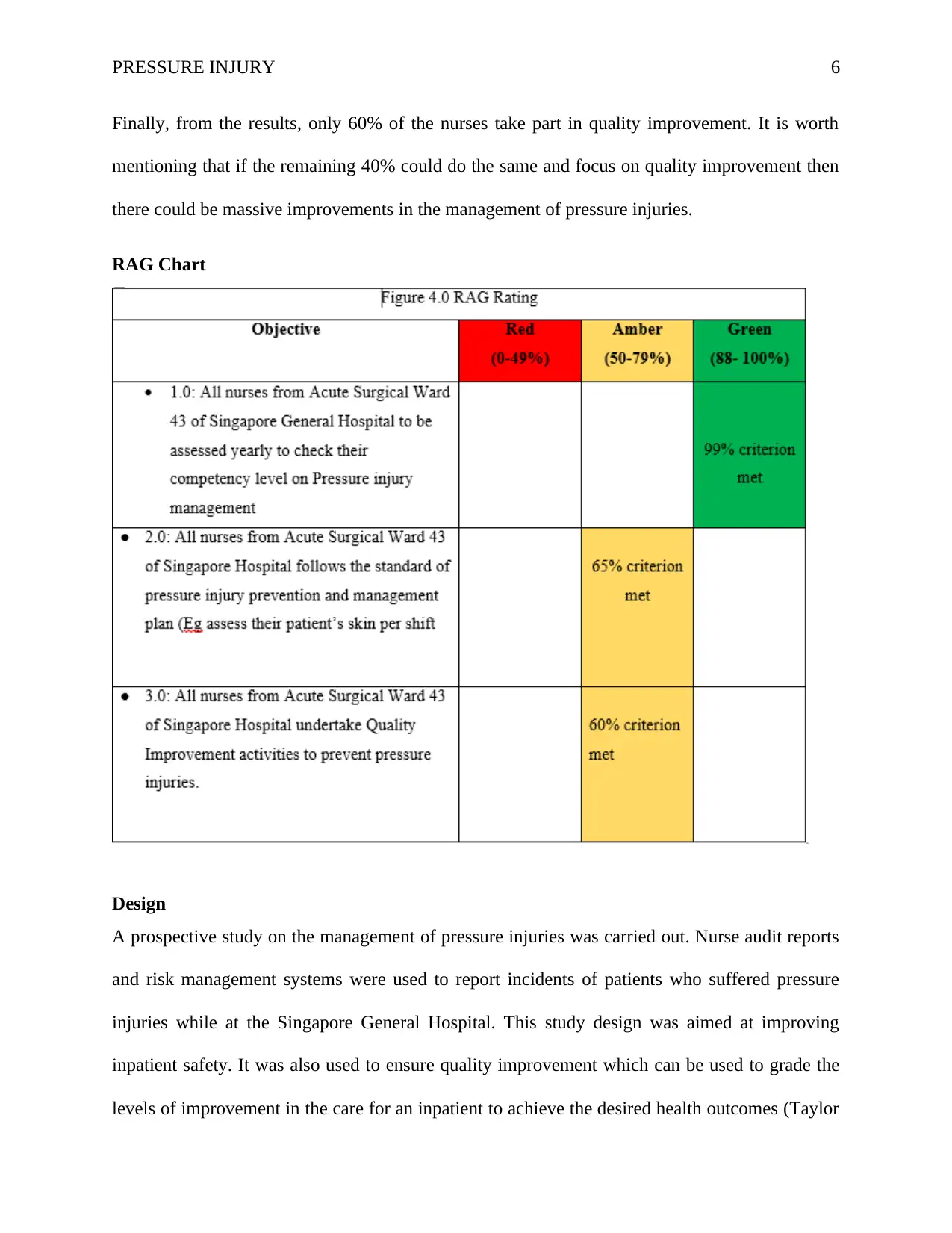
PRESSURE INJURY 6
Finally, from the results, only 60% of the nurses take part in quality improvement. It is worth
mentioning that if the remaining 40% could do the same and focus on quality improvement then
there could be massive improvements in the management of pressure injuries.
RAG Chart
Design
A prospective study on the management of pressure injuries was carried out. Nurse audit reports
and risk management systems were used to report incidents of patients who suffered pressure
injuries while at the Singapore General Hospital. This study design was aimed at improving
inpatient safety. It was also used to ensure quality improvement which can be used to grade the
levels of improvement in the care for an inpatient to achieve the desired health outcomes (Taylor
Finally, from the results, only 60% of the nurses take part in quality improvement. It is worth
mentioning that if the remaining 40% could do the same and focus on quality improvement then
there could be massive improvements in the management of pressure injuries.
RAG Chart
Design
A prospective study on the management of pressure injuries was carried out. Nurse audit reports
and risk management systems were used to report incidents of patients who suffered pressure
injuries while at the Singapore General Hospital. This study design was aimed at improving
inpatient safety. It was also used to ensure quality improvement which can be used to grade the
levels of improvement in the care for an inpatient to achieve the desired health outcomes (Taylor
⊘ This is a preview!⊘
Do you want full access?
Subscribe today to unlock all pages.

Trusted by 1+ million students worldwide
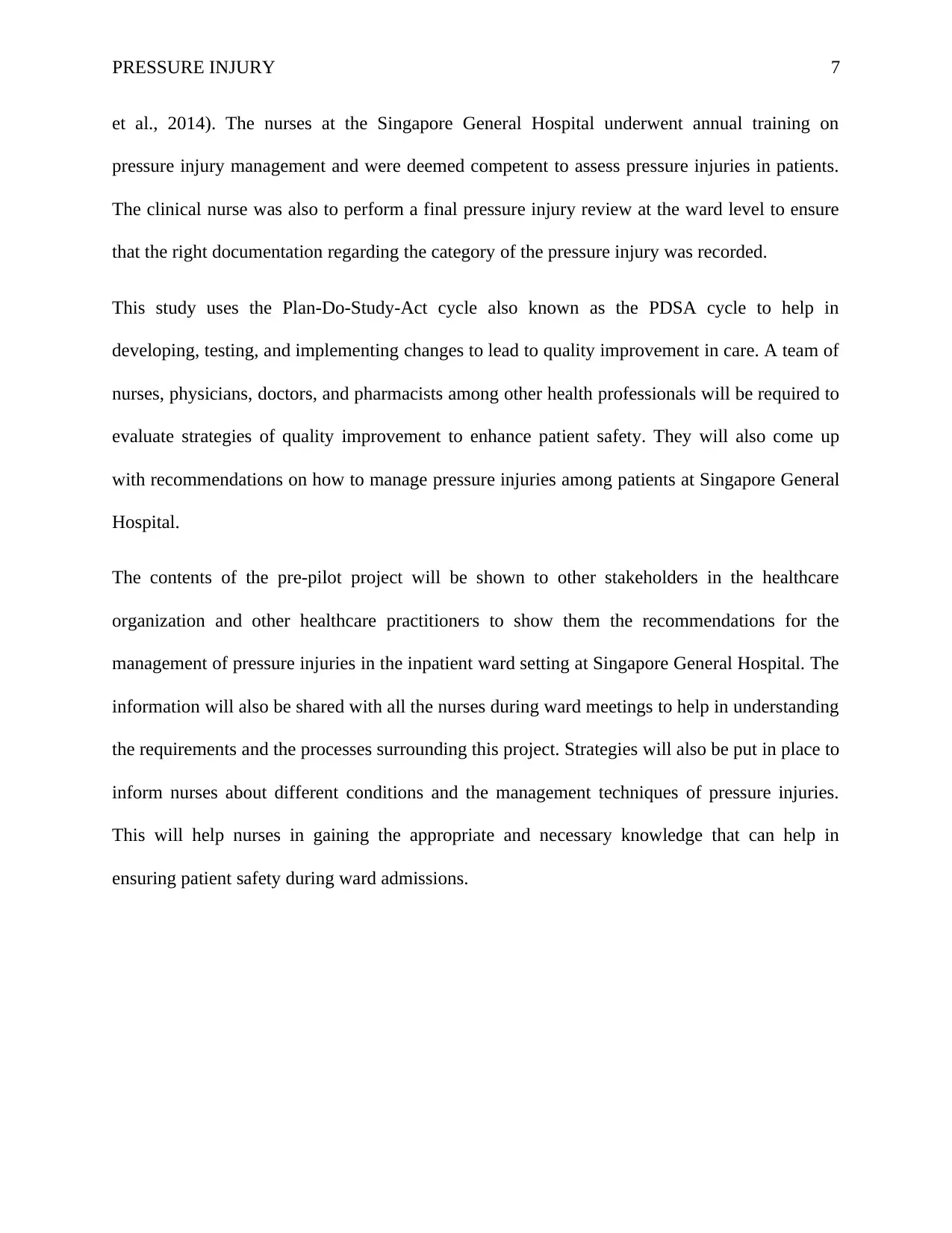
PRESSURE INJURY 7
et al., 2014). The nurses at the Singapore General Hospital underwent annual training on
pressure injury management and were deemed competent to assess pressure injuries in patients.
The clinical nurse was also to perform a final pressure injury review at the ward level to ensure
that the right documentation regarding the category of the pressure injury was recorded.
This study uses the Plan-Do-Study-Act cycle also known as the PDSA cycle to help in
developing, testing, and implementing changes to lead to quality improvement in care. A team of
nurses, physicians, doctors, and pharmacists among other health professionals will be required to
evaluate strategies of quality improvement to enhance patient safety. They will also come up
with recommendations on how to manage pressure injuries among patients at Singapore General
Hospital.
The contents of the pre-pilot project will be shown to other stakeholders in the healthcare
organization and other healthcare practitioners to show them the recommendations for the
management of pressure injuries in the inpatient ward setting at Singapore General Hospital. The
information will also be shared with all the nurses during ward meetings to help in understanding
the requirements and the processes surrounding this project. Strategies will also be put in place to
inform nurses about different conditions and the management techniques of pressure injuries.
This will help nurses in gaining the appropriate and necessary knowledge that can help in
ensuring patient safety during ward admissions.
et al., 2014). The nurses at the Singapore General Hospital underwent annual training on
pressure injury management and were deemed competent to assess pressure injuries in patients.
The clinical nurse was also to perform a final pressure injury review at the ward level to ensure
that the right documentation regarding the category of the pressure injury was recorded.
This study uses the Plan-Do-Study-Act cycle also known as the PDSA cycle to help in
developing, testing, and implementing changes to lead to quality improvement in care. A team of
nurses, physicians, doctors, and pharmacists among other health professionals will be required to
evaluate strategies of quality improvement to enhance patient safety. They will also come up
with recommendations on how to manage pressure injuries among patients at Singapore General
Hospital.
The contents of the pre-pilot project will be shown to other stakeholders in the healthcare
organization and other healthcare practitioners to show them the recommendations for the
management of pressure injuries in the inpatient ward setting at Singapore General Hospital. The
information will also be shared with all the nurses during ward meetings to help in understanding
the requirements and the processes surrounding this project. Strategies will also be put in place to
inform nurses about different conditions and the management techniques of pressure injuries.
This will help nurses in gaining the appropriate and necessary knowledge that can help in
ensuring patient safety during ward admissions.
Paraphrase This Document
Need a fresh take? Get an instant paraphrase of this document with our AI Paraphraser
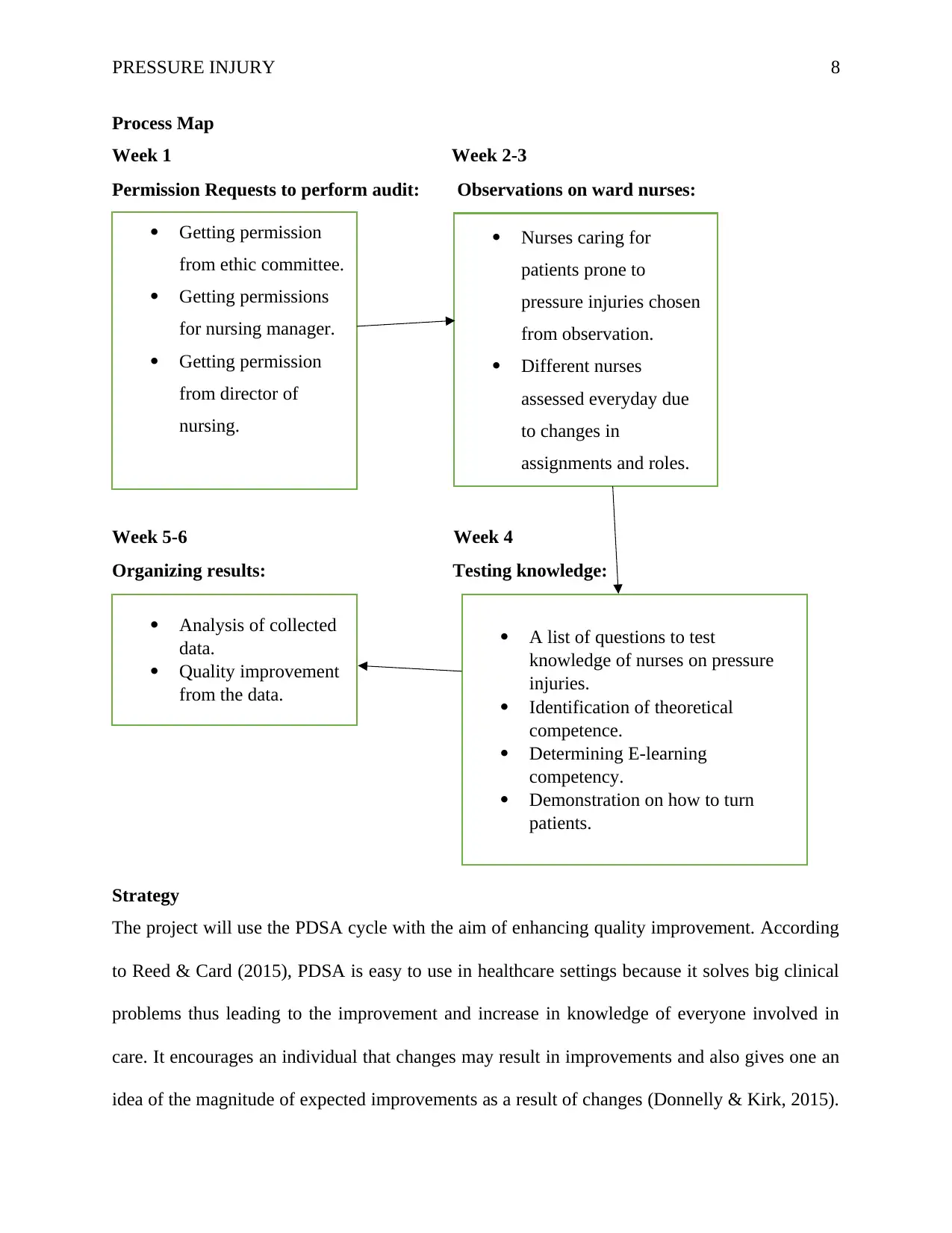
PRESSURE INJURY 8
Process Map
Week 1 Week 2-3
Permission Requests to perform audit: Observations on ward nurses:
Week 5-6 Week 4
Organizing results: Testing knowledge:
Strategy
The project will use the PDSA cycle with the aim of enhancing quality improvement. According
to Reed & Card (2015), PDSA is easy to use in healthcare settings because it solves big clinical
problems thus leading to the improvement and increase in knowledge of everyone involved in
care. It encourages an individual that changes may result in improvements and also gives one an
idea of the magnitude of expected improvements as a result of changes (Donnelly & Kirk, 2015).
Nurses caring for
patients prone to
pressure injuries chosen
from observation.
Different nurses
assessed everyday due
to changes in
assignments and roles.
A list of questions to test
knowledge of nurses on pressure
injuries.
Identification of theoretical
competence.
Determining E-learning
competency.
Demonstration on how to turn
patients.
Analysis of collected
data.
Quality improvement
from the data.
Getting permission
from ethic committee.
Getting permissions
for nursing manager.
Getting permission
from director of
nursing.
Process Map
Week 1 Week 2-3
Permission Requests to perform audit: Observations on ward nurses:
Week 5-6 Week 4
Organizing results: Testing knowledge:
Strategy
The project will use the PDSA cycle with the aim of enhancing quality improvement. According
to Reed & Card (2015), PDSA is easy to use in healthcare settings because it solves big clinical
problems thus leading to the improvement and increase in knowledge of everyone involved in
care. It encourages an individual that changes may result in improvements and also gives one an
idea of the magnitude of expected improvements as a result of changes (Donnelly & Kirk, 2015).
Nurses caring for
patients prone to
pressure injuries chosen
from observation.
Different nurses
assessed everyday due
to changes in
assignments and roles.
A list of questions to test
knowledge of nurses on pressure
injuries.
Identification of theoretical
competence.
Determining E-learning
competency.
Demonstration on how to turn
patients.
Analysis of collected
data.
Quality improvement
from the data.
Getting permission
from ethic committee.
Getting permissions
for nursing manager.
Getting permission
from director of
nursing.
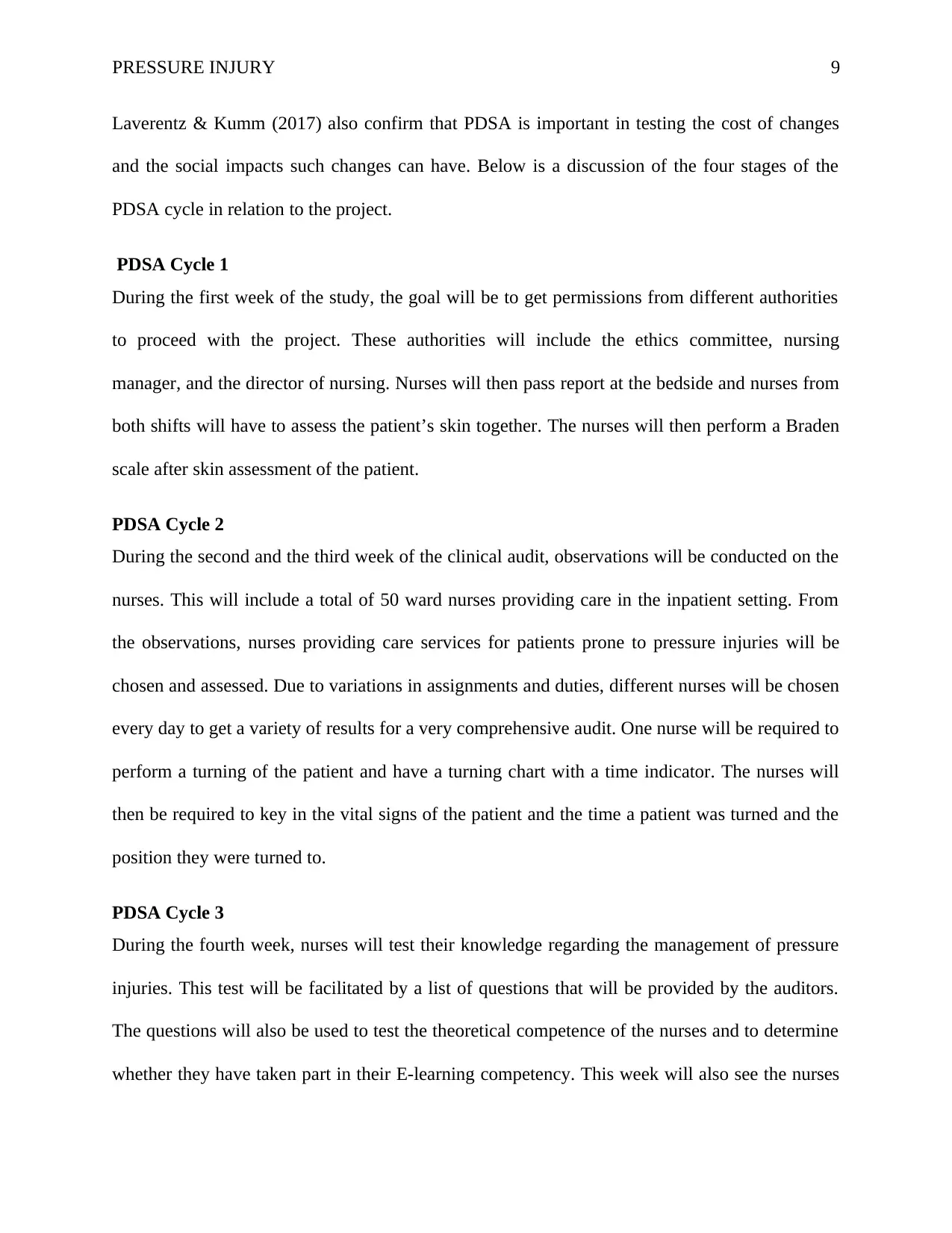
PRESSURE INJURY 9
Laverentz & Kumm (2017) also confirm that PDSA is important in testing the cost of changes
and the social impacts such changes can have. Below is a discussion of the four stages of the
PDSA cycle in relation to the project.
PDSA Cycle 1
During the first week of the study, the goal will be to get permissions from different authorities
to proceed with the project. These authorities will include the ethics committee, nursing
manager, and the director of nursing. Nurses will then pass report at the bedside and nurses from
both shifts will have to assess the patient’s skin together. The nurses will then perform a Braden
scale after skin assessment of the patient.
PDSA Cycle 2
During the second and the third week of the clinical audit, observations will be conducted on the
nurses. This will include a total of 50 ward nurses providing care in the inpatient setting. From
the observations, nurses providing care services for patients prone to pressure injuries will be
chosen and assessed. Due to variations in assignments and duties, different nurses will be chosen
every day to get a variety of results for a very comprehensive audit. One nurse will be required to
perform a turning of the patient and have a turning chart with a time indicator. The nurses will
then be required to key in the vital signs of the patient and the time a patient was turned and the
position they were turned to.
PDSA Cycle 3
During the fourth week, nurses will test their knowledge regarding the management of pressure
injuries. This test will be facilitated by a list of questions that will be provided by the auditors.
The questions will also be used to test the theoretical competence of the nurses and to determine
whether they have taken part in their E-learning competency. This week will also see the nurses
Laverentz & Kumm (2017) also confirm that PDSA is important in testing the cost of changes
and the social impacts such changes can have. Below is a discussion of the four stages of the
PDSA cycle in relation to the project.
PDSA Cycle 1
During the first week of the study, the goal will be to get permissions from different authorities
to proceed with the project. These authorities will include the ethics committee, nursing
manager, and the director of nursing. Nurses will then pass report at the bedside and nurses from
both shifts will have to assess the patient’s skin together. The nurses will then perform a Braden
scale after skin assessment of the patient.
PDSA Cycle 2
During the second and the third week of the clinical audit, observations will be conducted on the
nurses. This will include a total of 50 ward nurses providing care in the inpatient setting. From
the observations, nurses providing care services for patients prone to pressure injuries will be
chosen and assessed. Due to variations in assignments and duties, different nurses will be chosen
every day to get a variety of results for a very comprehensive audit. One nurse will be required to
perform a turning of the patient and have a turning chart with a time indicator. The nurses will
then be required to key in the vital signs of the patient and the time a patient was turned and the
position they were turned to.
PDSA Cycle 3
During the fourth week, nurses will test their knowledge regarding the management of pressure
injuries. This test will be facilitated by a list of questions that will be provided by the auditors.
The questions will also be used to test the theoretical competence of the nurses and to determine
whether they have taken part in their E-learning competency. This week will also see the nurses
⊘ This is a preview!⊘
Do you want full access?
Subscribe today to unlock all pages.

Trusted by 1+ million students worldwide
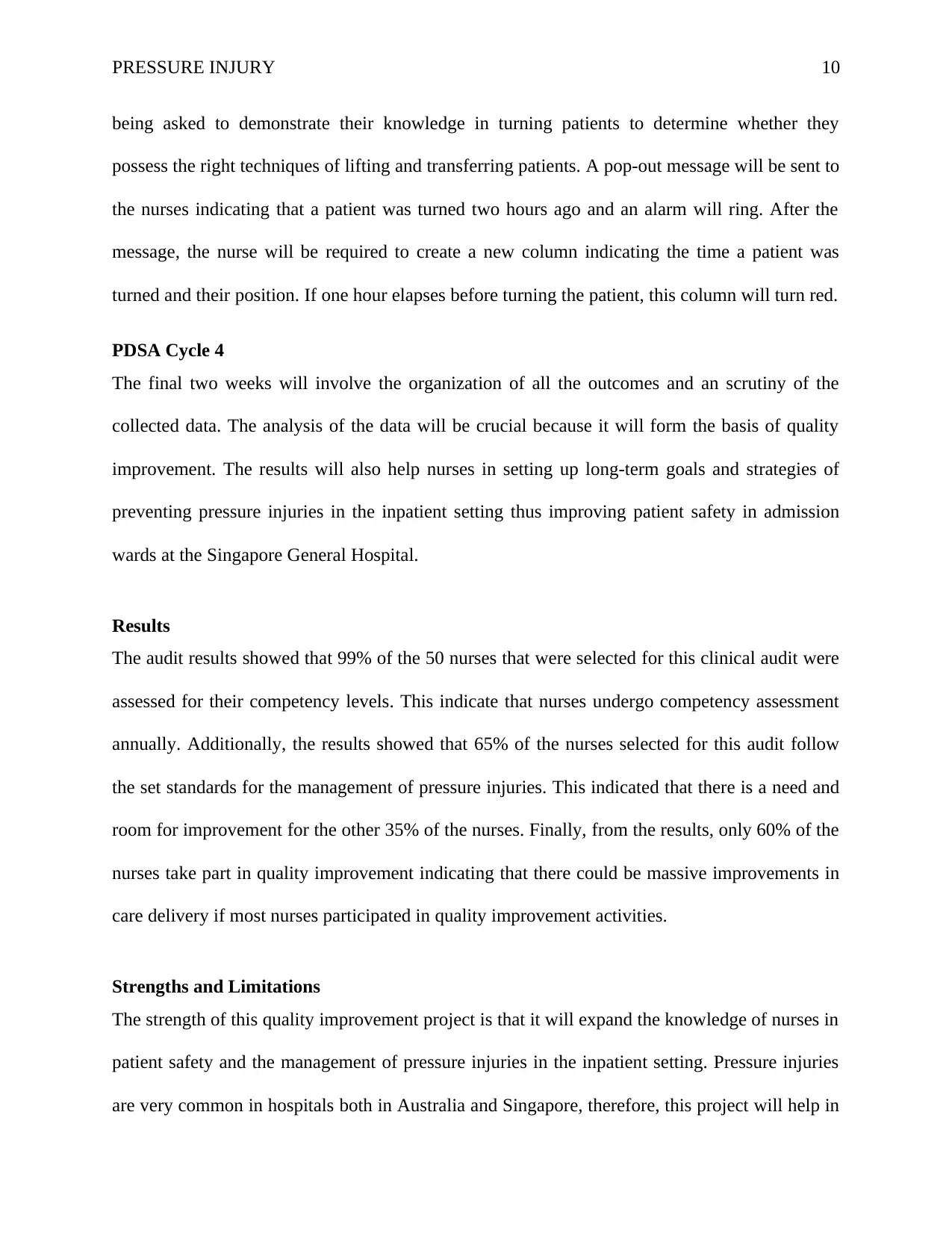
PRESSURE INJURY 10
being asked to demonstrate their knowledge in turning patients to determine whether they
possess the right techniques of lifting and transferring patients. A pop-out message will be sent to
the nurses indicating that a patient was turned two hours ago and an alarm will ring. After the
message, the nurse will be required to create a new column indicating the time a patient was
turned and their position. If one hour elapses before turning the patient, this column will turn red.
PDSA Cycle 4
The final two weeks will involve the organization of all the outcomes and an scrutiny of the
collected data. The analysis of the data will be crucial because it will form the basis of quality
improvement. The results will also help nurses in setting up long-term goals and strategies of
preventing pressure injuries in the inpatient setting thus improving patient safety in admission
wards at the Singapore General Hospital.
Results
The audit results showed that 99% of the 50 nurses that were selected for this clinical audit were
assessed for their competency levels. This indicate that nurses undergo competency assessment
annually. Additionally, the results showed that 65% of the nurses selected for this audit follow
the set standards for the management of pressure injuries. This indicated that there is a need and
room for improvement for the other 35% of the nurses. Finally, from the results, only 60% of the
nurses take part in quality improvement indicating that there could be massive improvements in
care delivery if most nurses participated in quality improvement activities.
Strengths and Limitations
The strength of this quality improvement project is that it will expand the knowledge of nurses in
patient safety and the management of pressure injuries in the inpatient setting. Pressure injuries
are very common in hospitals both in Australia and Singapore, therefore, this project will help in
being asked to demonstrate their knowledge in turning patients to determine whether they
possess the right techniques of lifting and transferring patients. A pop-out message will be sent to
the nurses indicating that a patient was turned two hours ago and an alarm will ring. After the
message, the nurse will be required to create a new column indicating the time a patient was
turned and their position. If one hour elapses before turning the patient, this column will turn red.
PDSA Cycle 4
The final two weeks will involve the organization of all the outcomes and an scrutiny of the
collected data. The analysis of the data will be crucial because it will form the basis of quality
improvement. The results will also help nurses in setting up long-term goals and strategies of
preventing pressure injuries in the inpatient setting thus improving patient safety in admission
wards at the Singapore General Hospital.
Results
The audit results showed that 99% of the 50 nurses that were selected for this clinical audit were
assessed for their competency levels. This indicate that nurses undergo competency assessment
annually. Additionally, the results showed that 65% of the nurses selected for this audit follow
the set standards for the management of pressure injuries. This indicated that there is a need and
room for improvement for the other 35% of the nurses. Finally, from the results, only 60% of the
nurses take part in quality improvement indicating that there could be massive improvements in
care delivery if most nurses participated in quality improvement activities.
Strengths and Limitations
The strength of this quality improvement project is that it will expand the knowledge of nurses in
patient safety and the management of pressure injuries in the inpatient setting. Pressure injuries
are very common in hospitals both in Australia and Singapore, therefore, this project will help in
Paraphrase This Document
Need a fresh take? Get an instant paraphrase of this document with our AI Paraphraser
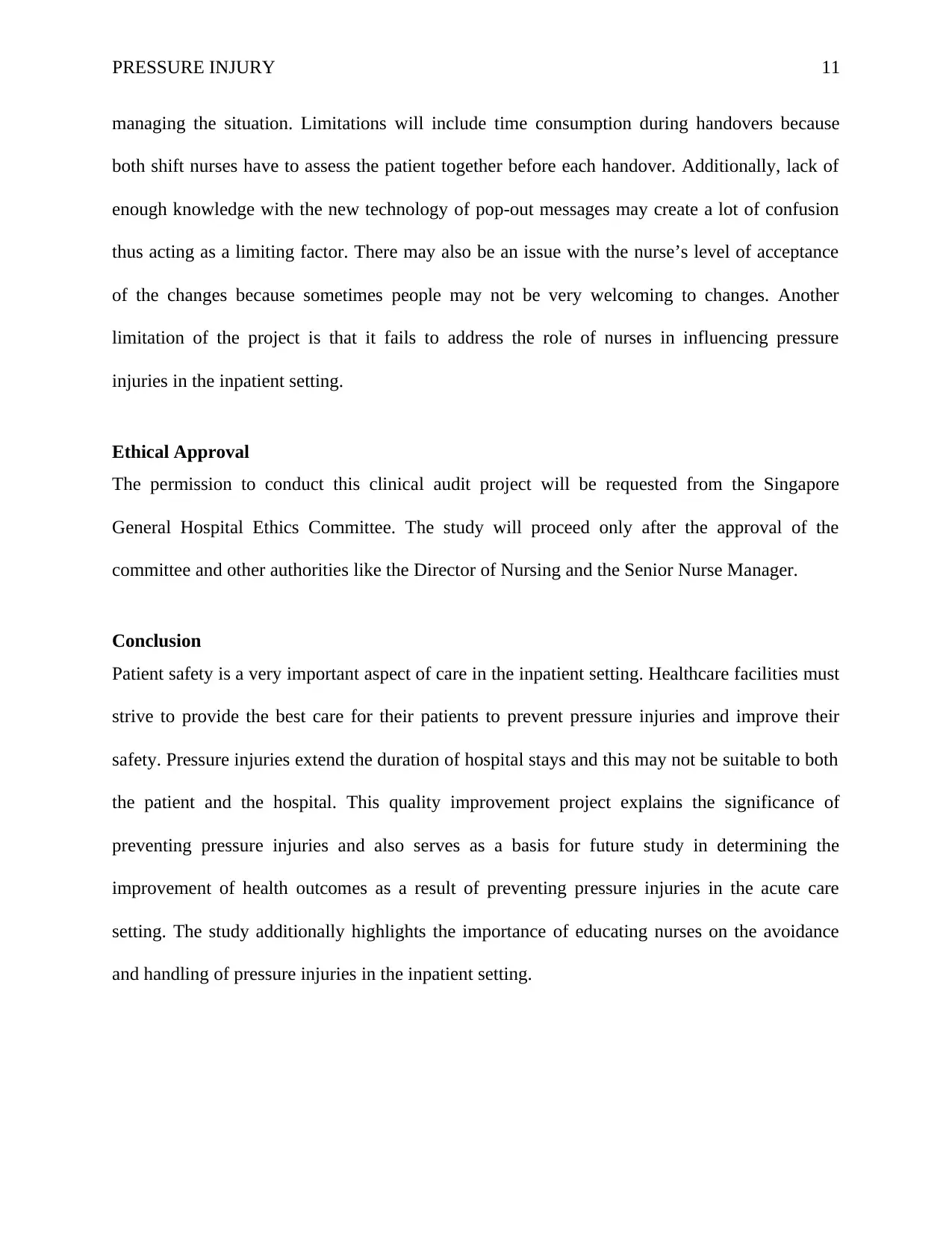
PRESSURE INJURY 11
managing the situation. Limitations will include time consumption during handovers because
both shift nurses have to assess the patient together before each handover. Additionally, lack of
enough knowledge with the new technology of pop-out messages may create a lot of confusion
thus acting as a limiting factor. There may also be an issue with the nurse’s level of acceptance
of the changes because sometimes people may not be very welcoming to changes. Another
limitation of the project is that it fails to address the role of nurses in influencing pressure
injuries in the inpatient setting.
Ethical Approval
The permission to conduct this clinical audit project will be requested from the Singapore
General Hospital Ethics Committee. The study will proceed only after the approval of the
committee and other authorities like the Director of Nursing and the Senior Nurse Manager.
Conclusion
Patient safety is a very important aspect of care in the inpatient setting. Healthcare facilities must
strive to provide the best care for their patients to prevent pressure injuries and improve their
safety. Pressure injuries extend the duration of hospital stays and this may not be suitable to both
the patient and the hospital. This quality improvement project explains the significance of
preventing pressure injuries and also serves as a basis for future study in determining the
improvement of health outcomes as a result of preventing pressure injuries in the acute care
setting. The study additionally highlights the importance of educating nurses on the avoidance
and handling of pressure injuries in the inpatient setting.
managing the situation. Limitations will include time consumption during handovers because
both shift nurses have to assess the patient together before each handover. Additionally, lack of
enough knowledge with the new technology of pop-out messages may create a lot of confusion
thus acting as a limiting factor. There may also be an issue with the nurse’s level of acceptance
of the changes because sometimes people may not be very welcoming to changes. Another
limitation of the project is that it fails to address the role of nurses in influencing pressure
injuries in the inpatient setting.
Ethical Approval
The permission to conduct this clinical audit project will be requested from the Singapore
General Hospital Ethics Committee. The study will proceed only after the approval of the
committee and other authorities like the Director of Nursing and the Senior Nurse Manager.
Conclusion
Patient safety is a very important aspect of care in the inpatient setting. Healthcare facilities must
strive to provide the best care for their patients to prevent pressure injuries and improve their
safety. Pressure injuries extend the duration of hospital stays and this may not be suitable to both
the patient and the hospital. This quality improvement project explains the significance of
preventing pressure injuries and also serves as a basis for future study in determining the
improvement of health outcomes as a result of preventing pressure injuries in the acute care
setting. The study additionally highlights the importance of educating nurses on the avoidance
and handling of pressure injuries in the inpatient setting.
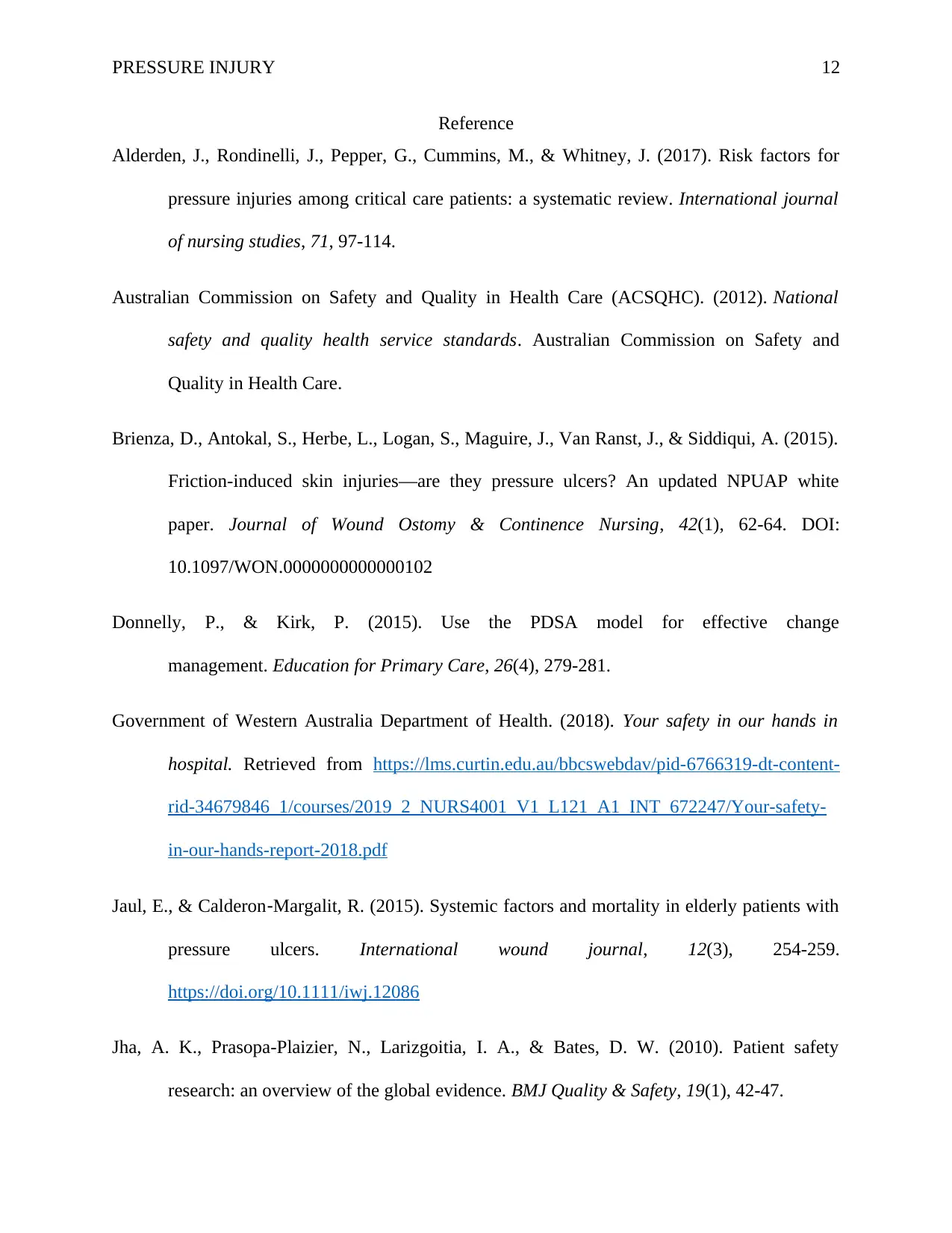
PRESSURE INJURY 12
Reference
Alderden, J., Rondinelli, J., Pepper, G., Cummins, M., & Whitney, J. (2017). Risk factors for
pressure injuries among critical care patients: a systematic review. International journal
of nursing studies, 71, 97-114.
Australian Commission on Safety and Quality in Health Care (ACSQHC). (2012). National
safety and quality health service standards. Australian Commission on Safety and
Quality in Health Care.
Brienza, D., Antokal, S., Herbe, L., Logan, S., Maguire, J., Van Ranst, J., & Siddiqui, A. (2015).
Friction-induced skin injuries—are they pressure ulcers? An updated NPUAP white
paper. Journal of Wound Ostomy & Continence Nursing, 42(1), 62-64. DOI:
10.1097/WON.0000000000000102
Donnelly, P., & Kirk, P. (2015). Use the PDSA model for effective change
management. Education for Primary Care, 26(4), 279-281.
Government of Western Australia Department of Health. (2018). Your safety in our hands in
hospital. Retrieved from https://lms.curtin.edu.au/bbcswebdav/pid-6766319-dt-content-
rid-34679846_1/courses/2019_2_NURS4001_V1_L121_A1_INT_672247/Your-safety-
in-our-hands-report-2018.pdf
Jaul, E., & Calderon‐Margalit, R. (2015). Systemic factors and mortality in elderly patients with
pressure ulcers. International wound journal, 12(3), 254-259.
https://doi.org/10.1111/iwj.12086
Jha, A. K., Prasopa-Plaizier, N., Larizgoitia, I. A., & Bates, D. W. (2010). Patient safety
research: an overview of the global evidence. BMJ Quality & Safety, 19(1), 42-47.
Reference
Alderden, J., Rondinelli, J., Pepper, G., Cummins, M., & Whitney, J. (2017). Risk factors for
pressure injuries among critical care patients: a systematic review. International journal
of nursing studies, 71, 97-114.
Australian Commission on Safety and Quality in Health Care (ACSQHC). (2012). National
safety and quality health service standards. Australian Commission on Safety and
Quality in Health Care.
Brienza, D., Antokal, S., Herbe, L., Logan, S., Maguire, J., Van Ranst, J., & Siddiqui, A. (2015).
Friction-induced skin injuries—are they pressure ulcers? An updated NPUAP white
paper. Journal of Wound Ostomy & Continence Nursing, 42(1), 62-64. DOI:
10.1097/WON.0000000000000102
Donnelly, P., & Kirk, P. (2015). Use the PDSA model for effective change
management. Education for Primary Care, 26(4), 279-281.
Government of Western Australia Department of Health. (2018). Your safety in our hands in
hospital. Retrieved from https://lms.curtin.edu.au/bbcswebdav/pid-6766319-dt-content-
rid-34679846_1/courses/2019_2_NURS4001_V1_L121_A1_INT_672247/Your-safety-
in-our-hands-report-2018.pdf
Jaul, E., & Calderon‐Margalit, R. (2015). Systemic factors and mortality in elderly patients with
pressure ulcers. International wound journal, 12(3), 254-259.
https://doi.org/10.1111/iwj.12086
Jha, A. K., Prasopa-Plaizier, N., Larizgoitia, I. A., & Bates, D. W. (2010). Patient safety
research: an overview of the global evidence. BMJ Quality & Safety, 19(1), 42-47.
⊘ This is a preview!⊘
Do you want full access?
Subscribe today to unlock all pages.

Trusted by 1+ million students worldwide
1 out of 14
Related Documents
Your All-in-One AI-Powered Toolkit for Academic Success.
+13062052269
info@desklib.com
Available 24*7 on WhatsApp / Email
![[object Object]](/_next/static/media/star-bottom.7253800d.svg)
Unlock your academic potential
Copyright © 2020–2025 A2Z Services. All Rights Reserved. Developed and managed by ZUCOL.





